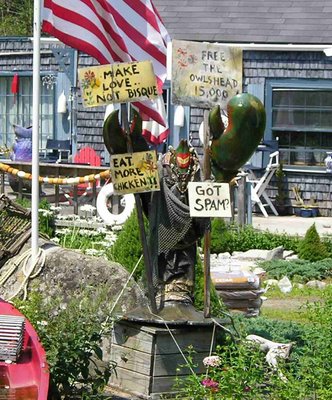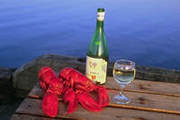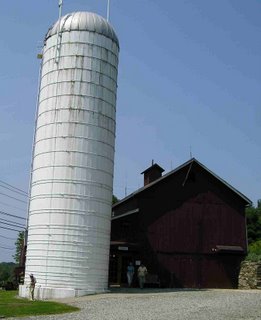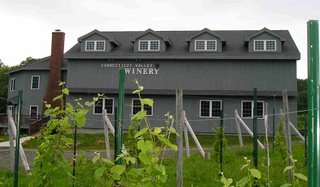I hit the
Connecticut Wine Trail again recently, and I'm happy to report that Kathy and I had a terrific tasting experience at the
Hopkins Vineyard in New Preston, Conn. Not only do they make some very good wines, they enjoy one of the prettiest settings around, on a hill overlooking
Lake Waramaug. It also has a 200-year-old pedigree as a farm and is one of the older Connecticut vineyards, though the first vines were planted in 1979.
The FacilitiesIf I can revisit my theory about visiting wineries, for a minute, I believe most visitors to wineries are not wine experts but tourists or yuppies out for a weekend, looking for a taste of that wine
experience they hear so much about in California. They do not need to be hit over the head with $100 cabernet; they just need to feel like they're immersed in the real deal, and that the wine is good enough to buy so that they can celebrate the adventure again later.

I can tell you that Hopkins will probably come closer to meeting most people's expectations than will most other wineries in Connecticut. In fact, I would compare it to many of the good Long Island vineyards we've visited and even some of the more pastoral wineries we've visited in California in Paso Robles and the Sierra foothills -- except for the quality of the reds.
From the outside, Hopkins looks like a picturesque red barn but otherwise does not promise much. In fact, it is a very accommodating environment in which to soak up the wine experience. The winery includes extensive retail space for all kinds of wine-related purchases (my wife's favorite so far) and a very nice winetasting bar. Upstairs, the winery hosts a lovely cafe featuring wine by the glass, cheese plates and some other nibbles to enjoy with the wine.
Off the winetasting room, you can follow a self-guided tour into the winery itself and check out the fermentation tanks and oak barrels. Very nice ambience. The only complaint I have is that with all that space, could they have made the winetasting bar a bit bigger. When we were there, there were not very many people, but we still had a hard time getting space at the bar.
Still, the accommodations are really enjoyable and bound to make virtually everyone feel like they truly are in wine country. And, they can choose between browsing, winetasting or enjoying a leisurely light lunch in the cafe. I give the facilities a
5 out 5 score.
The StaffHopkins appears to be a fairly big operation, compared to other Connecticut wineries, and so they employ a number of young people to conduct their tastings. Consequently, you're not likely to meet the winemaker or gain some first-hand knowledge of vineyard conditions.
The young pourers were fairly knowledgable, if unexcited about the products. They had memorized flavor profiles and were prepared to answer most questions. But what they lacked was any real passion for the wines and, consequently, fell a bit short in stirring real excitement in us. Not that this is much different from some of the best wineries. I recall having really sensational wines at a Washington State winery a few years back, only to have the experience soured by a thoroughly bored, even acerbic young blond woman.
Still, some real insight and passion could really help enthuse those just learning about wines. So I give the staff here a
3 out 5 score.
The WinesLet's start out by noting that winetasting at Hopkins will cost you $5.30 per person, or $7.50 for the full line-up, including the ice wine but excluding the sparkling wine. These prices are consistent with what wineries charge in many other states, but it doesn't seem like that long ago that Connecticut wineries were charging little or nothing. Ah, the good old days.
The good news -- Hopkins makes some excellent white wines. The bad news -- I'm still searching for a good Connecticut red. Here we go:
2003 Estate Bottled Chardonnay $15.99. Very nice, barrel fermented and aged in both American and French oak, it imparts some nice butter and apple spice aromas with a crisp finish.
2004 Estate Bottled Duet $10.99. A blend of chardonnay and vidal blanc, this wine has excellent fruit and pleasant acidity, very little oak.
2005 Vineyard Reserve $12.50. Made from seyval blanc and vidal blanc grapes, this wine is a nice, light, crisp package with notes of fig.
2003 Estate Bottled Cabernet Franc $17.95. It starts out with a spicy tart cherry taste that quickly fades into a thin, diluted imitation of cab franc. Surprisingly, it achieves 13 percent alcohol but not the extraction to match. I'm told they really do make good cabernet franc, and that the previous vintage was much better. But '03 was nothing to write home, or even send a postcard, about.
Red Barn Red $12.50. This blend of cab franc and three hybrid grapes was interesting for its gamay-like flavors, despite a slightly sour finish. Not too bad.
2004 Estate Bottled Westwind $10.99. A semi-sweet wine, it showed some nice citrus notes and decent acidity.
Sachem's Picnic $10.99. Semi-sweet and simplistic. Definitely disappointing.
2003 Estate Bottled Vidal Blanc $13.99. This late harvest dessert wine had a hint of an apricot nose but was quite sweet without the needed acidity. Fair.
2003 Estate Bottled Ice Wine $39.50. This ice wine was very nice indeed, with honey and apricot aromas. While ice wines are traditionally labor intensive and expensive to make, the price feels a little steep for Connecticut. But it really is a very enjoyable dessert wine.
While Hopkins did little to unhinge my antipathy for Connecticut reds, it showed more promise than the other wineries we've visited so far. And, many of the whites really are very good. I think most people would very much enjoy tasting these wines, so I give them a score of
8 out of 10.
Overall, I think the Hopkins offers winetasters a very enjoyable experience. It also offers the convenience of being located in an ideal, pastoral tourist location next to a popular inn and restaurant. My total score for Hopkins is
16 out of 20 -- the highest score so far and a number that could easily increase even higher with a little extra effort from the staff.
NOTE: While most reviews tend to look only at the wines, I believe visiting wineries is as much about an "experience" as it is about the quality of wines. Wineries probably get more tourists than wine geeks for visitors, and I think they're looking for a combination of comfortable, wine-focused facilities, knowledgable and passionate staff, and enjoyable wines. So, I'm assigning scores to each winery on a 20-point scale. 5 potential points for enjoyable, mood-enhancing ambience; 5 for knowledgable, enthusiastic staff; and 10 for quality wines. The scores are purely a result of my personal judgment; I have no relationship to any of the wineries.











